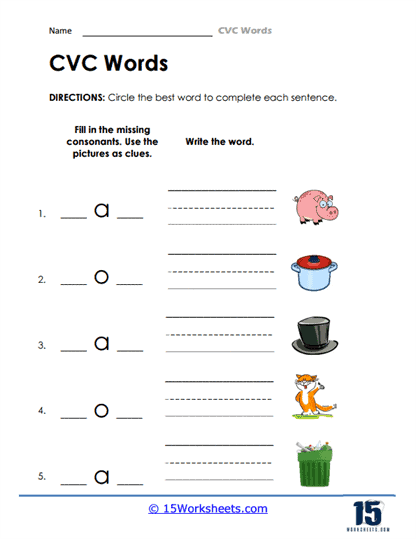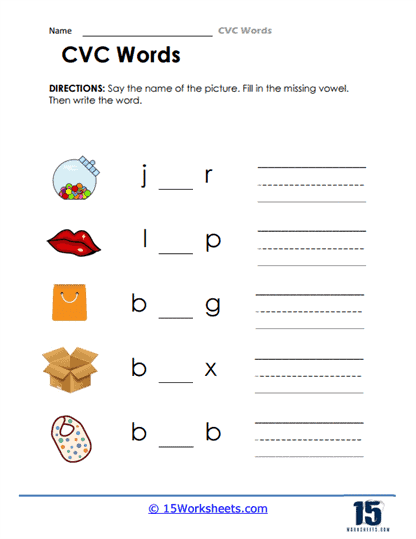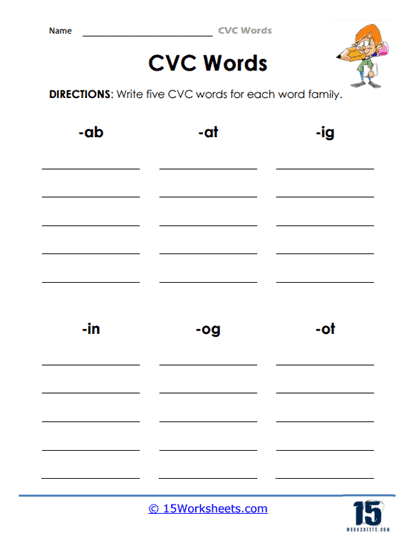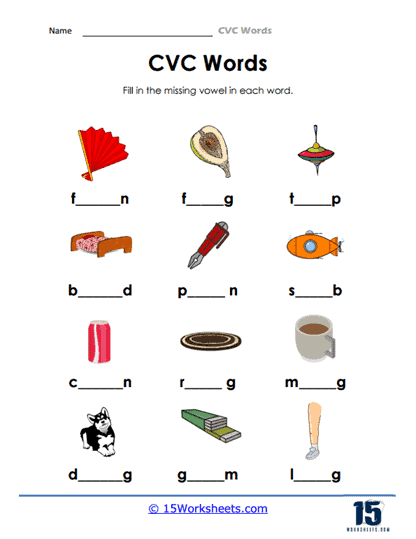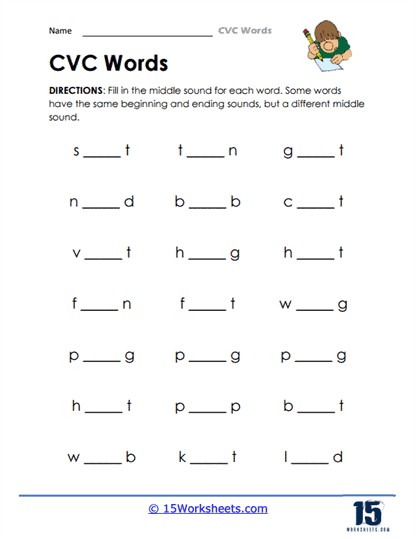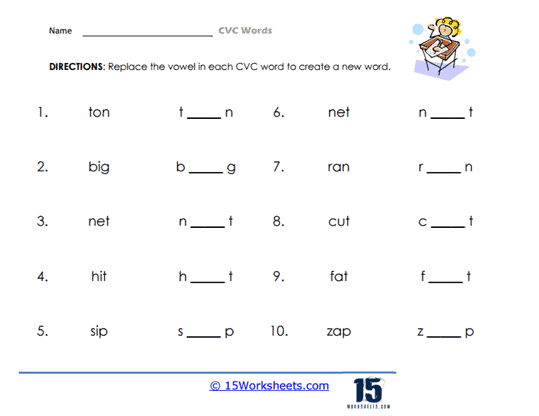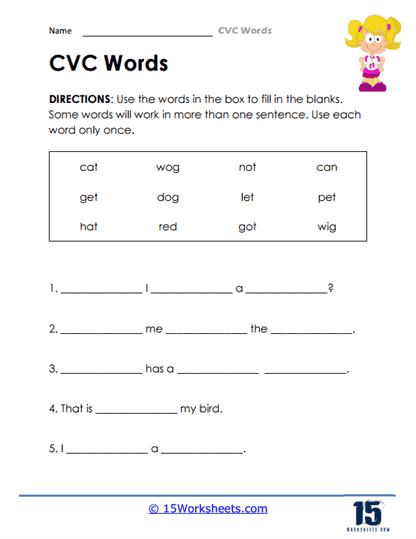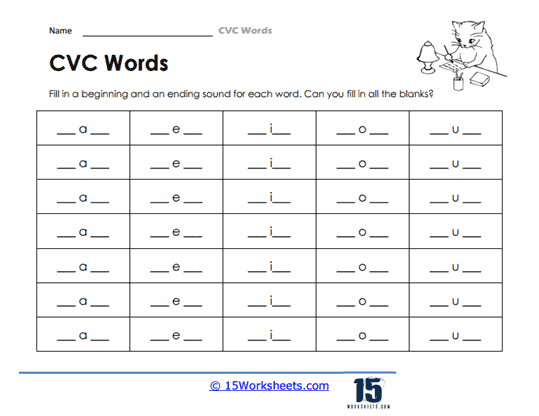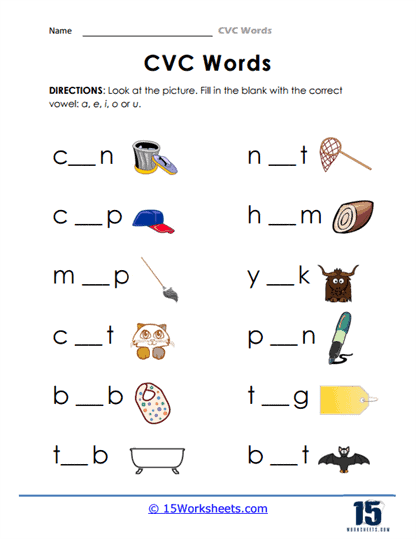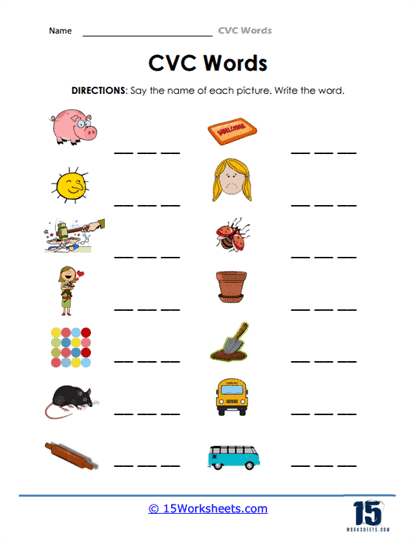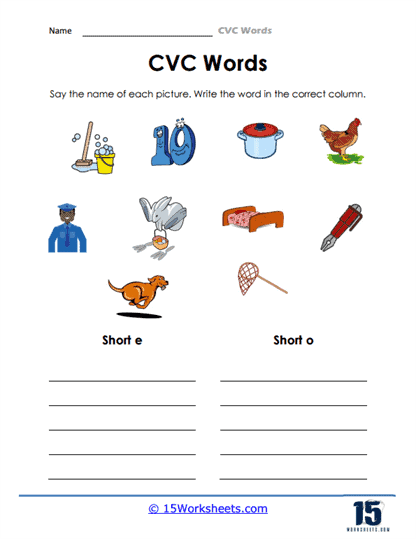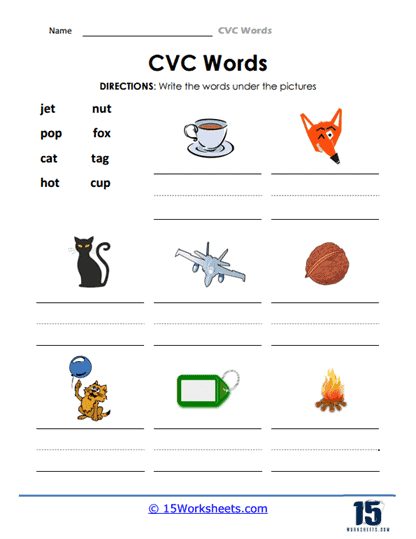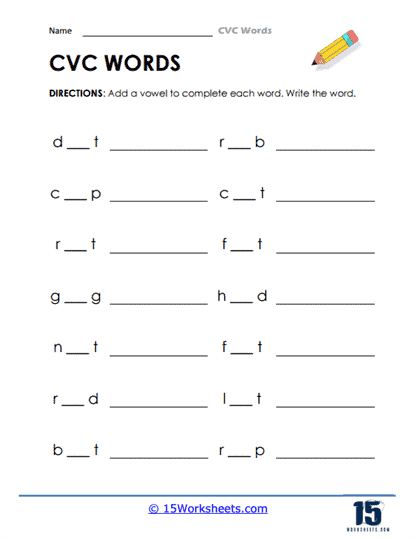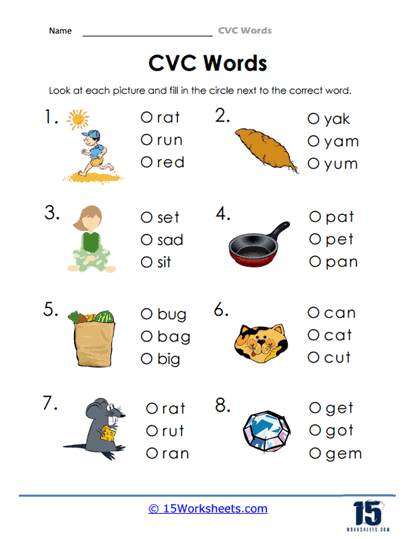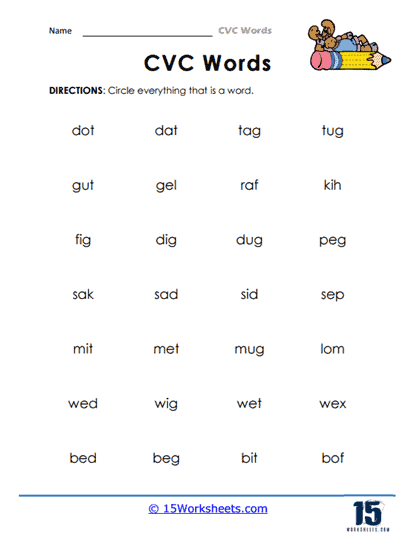CVC Words Worksheets
All About These 15 Worksheets
Unlock the door to early literacy success with our meticulously designed collection of CVC (Consonant-Vowel-Consonant) Words worksheets-a resource that doesn’t just teach, but transforms the way students engage with language. This comprehensive set of worksheets is built to lay a rock-solid foundation in reading and spelling, empowering students to decode words effortlessly and build confidence in their phonetic abilities. For any educator or parent eager to boost a child’s literacy skills, these worksheets offer a unique blend of structure, engagement, and fun.
CVC words are more than just three-letter combinations; they are the stepping stones to fluent reading and effective spelling. These words, such as “cat,” “pig,” “cup,” and “dog,” represent the most basic building blocks of English phonics. Mastery of these fundamental word patterns allows young learners to tackle more complex words and begin their journey towards reading proficiency with ease. With the help of this resource, students won’t just memorize word shapes-they’ll truly understand how letters and sounds work together, setting the stage for lifelong literacy.
Each worksheet is thoughtfully crafted to go beyond rote learning. Activities such as matching, sorting, and writing exercises are designed to cater to different learning styles, ensuring every student has an opportunity to shine. For kinesthetic learners, we’ve included cutting and pasting exercises that make learning interactive and hands-on. Visual learners will appreciate colorful illustrations that bring CVC words to life, while auditory learners can benefit from sound-based activities that reinforce the relationship between letters and their sounds. These varied approaches work together to ensure that every child finds a way to connect with the material.
Repetition is the key to mastery, and our worksheets offer numerous ways for students to revisit and reinforce what they’ve learned. By engaging in consistent practice, students gain confidence in their ability to recognize patterns in words, decode unfamiliar terms, and spell accurately. This not only strengthens their reading fluency but also helps them develop the critical thinking skills needed to tackle more challenging vocabulary in the future.
As an educator, your time is precious, and we understand that creating quality resources can be a time-consuming task. That’s why we’ve done the heavy lifting for you. Our CVC Words worksheets are designed to seamlessly fit into your lesson plans, providing structured, ready-to-use materials that cover all aspects of CVC word recognition and application. This resource saves you time on preparation, allowing you to focus on what matters most-guiding your students on their learning journey.
The value of this resource extends beyond the classroom. CVC words form the foundation of many everyday terms that children encounter in their environment. By mastering CVC words, students become better equipped to understand signage, captions, storybooks, and even simple instructions. The skills gained here will enable them to approach new words with confidence, fostering a love for reading and a curiosity for learning that will last a lifetime.
One of the standout features of our CVC Words worksheets is their versatility. The activities are scaffolded to support a range of proficiency levels, making it easy to differentiate instruction and meet each student where they are. Beginners can start with simple sound-matching exercises, while more advanced learners can move on to sentence-building and story-writing activities using CVC words. This flexibility ensures that as your students grow, these worksheets continue to challenge and engage them, offering a continuous path of growth.
CVC words are a crucial part of early literacy, but they are just one piece of the puzzle. That’s why we’ve incorporated activities that connect CVC words to broader phonics principles, such as blending, segmenting, and rhyming. Through these exercises, students develop a holistic understanding of phonics that goes beyond isolated word practice. They learn to see the patterns and relationships that govern the English language, preparing them for a smoother transition to more advanced reading and writing.
Types of Exercises
CVC words are the building blocks of early literacy, and what better way to explore their mysteries than with a series of worksheets that feel like a detective novel, a game show, and a comedy of phonics errors all rolled into one? In The Missing Consonants, students take on the role of linguistic archaeologists, unearthing forgotten consonants from ancient three-letter ruins. It’s a race against time as they try to restore order to a chaotic alphabet. The only thing standing between “_at” and a successful feline rescue is their mastery of the letter “c.” The stakes are high. Somewhere, a sad, incomplete “_og” is waiting to bark again.
But not so fast! Before anyone earns their decoder badge, they must become a Vowel Detective, scouring the silent landscape of partially-built words to uncover the true identities of rogue vowels. Is that a “cap,” a “cup,” or-dare we say-a “cop”? The clues are there if you read between the lines (and sound out the syllables). Next, in Five For Each, kids must conjure five unique CVC words for each vowel sound. It’s like speed-dating for vowels-short, sweet, and potentially confusing if you mistake “pig” for a romantic prospect.
Visual Context asks students to gaze into the soul of an image-usually a cartoonish cow or a banana with eyes-and name what they see, letter by letter. If the Mona Lisa had a label, it would probably read “gal,” thanks to this exercise. Then comes The Middle Sound, which is a bit like being a vowel therapist. Students have to tune in to the emotional center of each word, listening for that fragile, mid-word hum. Only by embracing the awkward “e” in “bed” or the haunted “u” in “mug” can they bring phonetic peace to the page.
Of course, things get chaotic with Transformation Challenge, where one letter changes and everything goes to phonics heck. “Cat” becomes “cut,” and suddenly the cat’s been to the groomer. Sentence Magic is where budding magicians take their humble CVC words and conjure full sentences out of them. “The dog ran” might not be Shakespeare, but for a kindergartner, it’s basically Macbeth. Meanwhile, CVC Word Puzzles and Picture Perfect Fill-Ins offer the crossword experience for people who still think “jam” is just a sticky food and not a traffic problem.
Just Three Letters is as minimalist as it gets-like a haiku made entirely of training wheels. Students explore the poetry of pure phonics simplicity. Short E And Short O throws in a bit of drama, pitting vowels against each other in a turf war over pronunciation. Who knew “bed” and “pot” would be so territorial? Label The Image invites students to stick names on pictures like a linguistic game of pin-the-tail-on-the-donkey. Accuracy is key. Nobody wants to label a “net” as a “nap.” That’s how fish get lost.
Complete And Write, Choose The Right Word, and the epic-sounding Wordhunt Exercise round out the saga. These are where students synthesize their phonics power, filling blanks, spotting impostors, and hunting down elusive CVCs like literacy bloodhounds. By the end of this worksheet odyssey, they’ve become warriors of word construction, defenders of three-letter logic, and pun-loving phoneme philosophers. All in all, it’s a beautifully absurd, oddly profound journey into the very core of language.
What Are CVC Words?
CVC words are three-letter words that follow the pattern of a consonant (C), a vowel (V), and another consonant (C). These words are typically short, simple, and easy to read, making them ideal for teaching young children and beginner readers the basic principles of phonics and reading. In CVC words, each letter represents a single phoneme, and the vowel sound is usually short.
Some examples of CVC words include:
“cat” (C: /k/, V: /æ/, C: /t/)
“dog” (C: /d/, V: /ɒ/, C: /ɡ/)
“hat” (C: /h/, V: /æ/, C: /t/)
“mop” (C: /m/, V: /ɒ/, C: /p/)
“sun” (C: /s/, V: /ʌ/, C: /ℼ/)
CVC words are often used in early literacy education as they provide a simple and accessible introduction to reading. By learning to read and decode CVC words, children can build their phonemic awareness, phonics skills, and reading confidence, which will help them progress to more complex words and texts as they continue to develop their reading abilities.
How to Teach Kids CVC Words
Teaching kids CVC words is an important step in helping them develop early reading skills. Here’s a step-by-step guide on how to teach CVC words to young children:
Introduce phonemic awareness – Begin by helping children recognize and differentiate individual sounds (phonemes) in spoken language. Use simple activities such as sound matching, sound isolation, and sound blending.
Teach letter-sound correspondence – Introduce the alphabet and ensure that children can associate each letter with its corresponding sound. Use visual aids, songs, and games to help them memorize and understand these relationships.
Start with simple CVC words – Choose CVC words that use common, simple consonants and short vowel sounds, such as “cat,” “dog,” “mop,” or “sit.” Focus on one CVC word at a time.
Break down the word into phonemes – Help children identify the individual phonemes in the CVC word. For example, in the word “cat,” the phonemes are /k/, /æ/, and /t/.
Blend the sounds – Encourage children to blend the phonemes together to form the word. In the case of “cat,” they should practice blending /k/-/æ/-/t/ to create the word.
Use visual aids – Flashcards, magnetic letters, and other visual aids can help children make connections between the written word and its pronunciation. Show them the written CVC word and help them connect the letters to the sounds they’ve practiced.
Practice reading and writing – Have children practice reading the CVC word and writing it down. Reinforce the connection between the letters, phonemes, and the complete word.
Create variety and repetition – Introduce new CVC words gradually, ensuring that children have mastered the previous ones. Review and practice regularly to help them build a solid foundation of CVC words.
Play games and use engaging activities – Make learning fun by incorporating games and activities, such as memory games, word puzzles, and bingo. This keeps children engaged and motivated while they learn.
Encourage independent reading – As children become more confident with CVC words, encourage them to read simple books or texts that contain these words. This will help them build their reading fluency and comprehension skills.
Remember, learning to read takes time and patience. Be supportive and encouraging, and adjust your teaching pace according to each child’s needs and progress.
This collection of CVC Words worksheets is an invaluable resource that equips educators to guide their students toward phonetic excellence. By engaging with these worksheets, students not only develop a strong foundation in CVC words but also set the stage for successful reading, spelling, and overall literacy. This collection empowers educators to nurture young learners on their journey to becoming confident and proficient readers and communicators.

